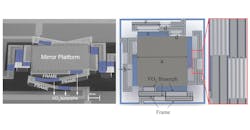Scientists from the Air Force Research Laboratory (AFRL) Sensors Directorate, Integrated Circuits and Microsystems branch, in tandem with researchers from Michigan State University, are developing microelectromechanical-systems (MEMS) mirrors based on smart materials which could be the basis for cloaking devices. In the research, vanadium dioxide (VO2) was used as a microactuator for the MEMS devices, allowing for the possibility of extremely low-power operation in practical applications (see figure).
The two groups entered into a five-year cooperative research-and-development agreement (CRADA) to combine the AFRL’s expertise on MEMS design with MSU’s knowledge on the deposition and characterization of VO2. The agreement provides MSU’s scientists with access to Air Force facilities, personnel, and materials to create VO2 films, as well as to integrate them into MEMS devices for testing.
“Our collaboration with Michigan State University has been invaluable in advancing the science and technology of micro actuators and micro mirrors,” said Dr. John Ebel from the AFRL Sensors Directorate. “Their expertise combined with AFRL’s unique fabrication capabilities and talents has greatly accelerated the pace of research for MEMS actuators and mirrors.”
“This CRADA has allowed for the use of unprecedented mechanisms in the operation of MEMS mirrors,” added Nelson Sepulveda, a professor of electrical and computer engineering at Michigan State. “We have also made promising advances in implementing new techniques that can significantly advance military technologies, such as the use of smart windows that could potentially serve for cloaking applications.” The research team is also exploring the use of VO2-actuated MEMS devices as optical attenuators.
About the Author
Jack Browne
Technical Contributor
Jack Browne, Technical Contributor, has worked in technical publishing for over 30 years. He managed the content and production of three technical journals while at the American Institute of Physics, including Medical Physics and the Journal of Vacuum Science & Technology. He has been a Publisher and Editor for Penton Media, started the firm’s Wireless Symposium & Exhibition trade show in 1993, and currently serves as Technical Contributor for that company's Microwaves & RF magazine. Browne, who holds a BS in Mathematics from City College of New York and BA degrees in English and Philosophy from Fordham University, is a member of the IEEE.

